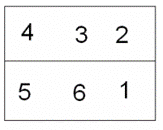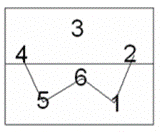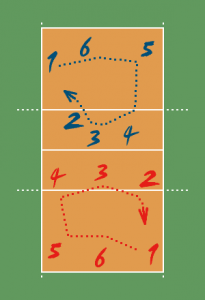Main Body
5. Strategies
Rotations
There are many different ways of rotating and subbing. For general pick-up games and games with 6 players, the rotation is clockwise.
Click on the image below to watch a video of this rotation by The Art of Coaching Volleyball.
At elite levels like high school, club, and pro volleyball, each player has specific skills. For instance, one player may be good at defense only and therefore is a good passer (bumper). Other players are tall or can jump high and are good hitters and blockers, but may not be great at passing (bumping). Coaches at these levels use substitutions, liberos (defensive specialists), and many different rotations (which may look like weird to beginners), all with the intent to maximize the strengths of each player. The same positions apply as the above rotation. However, often players are not in those positions before the ball is served. They bunch up and change positions on the court once the serve is made to maximize each player’s strengths.
Here are different options for a team’s offense:
- 6-2 Offense: 6 attackers, while two are capable setters; setter in the back row runs the offense, while setter in the front row is attacking. This allows for maximum variation on offense, but requires high team level of coordination
- 4-2 Offense: 4 attackers, while two are capable setters; setter in the front row runs the offense, setter in the back row plays defense. This allows for increased ball control on the first contact, but eliminates an offensive weapon.
- 5-1 Offense: 5 attackers, 1 setter. Advantage of one player to run the offense
Defense
First, check out a video presented by Jonathan Neeley regarding basic defensive position.
There are different defensive strategies which can turn to offense very quickly. Beginners should position themselves in a W-formation for defense and to receive the serve.


Teams may use different types of defensive sets, but the following principles should be kept in mind when playing defense:
- Try to block the attack (1st line of defense)
- Someone cover tips
- Ensure the court is covered and there are no open areas of the court
- Hit the ball high enough for others to get under it
- Go after every ball
- Stay active and move your feet
- Try to get the first ball that comes over the net to the area where your setter is located
- Try to turn your defense into an offense (with a bump, set and spike)


